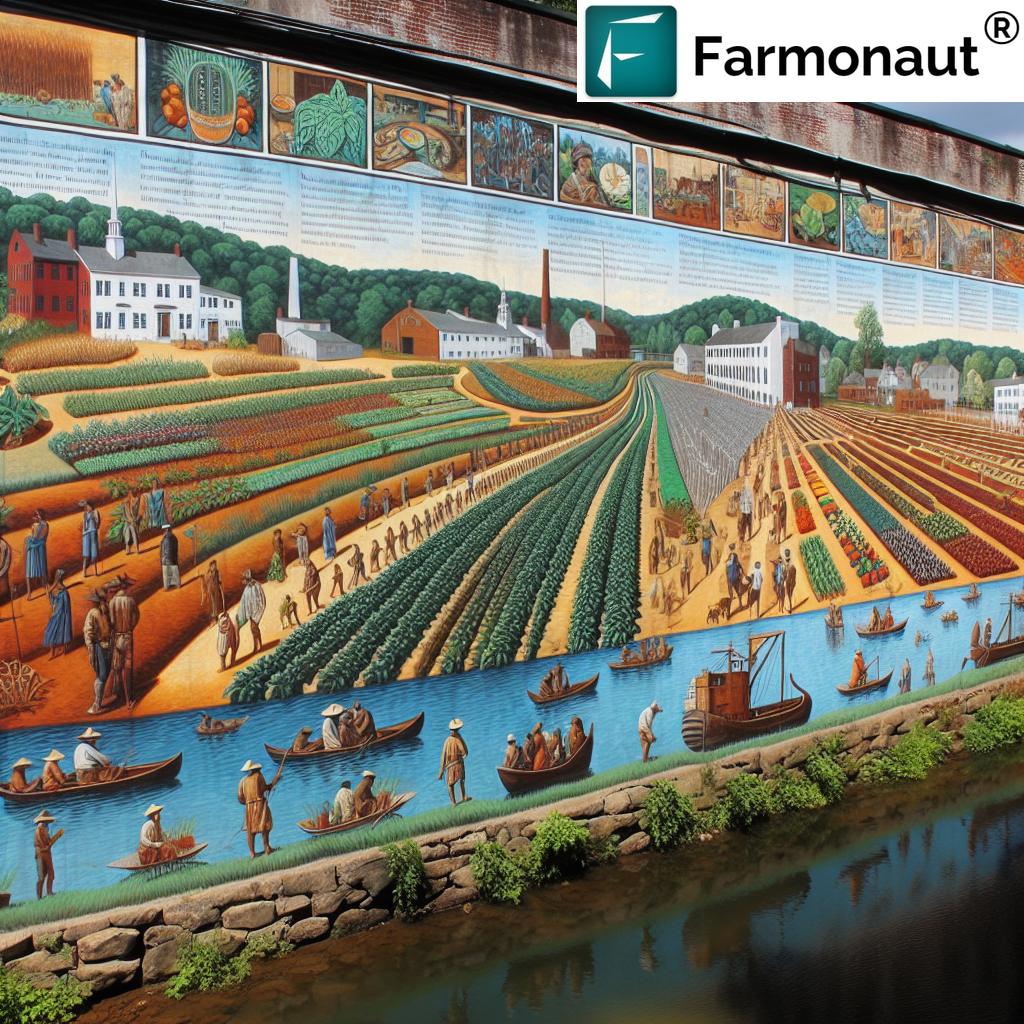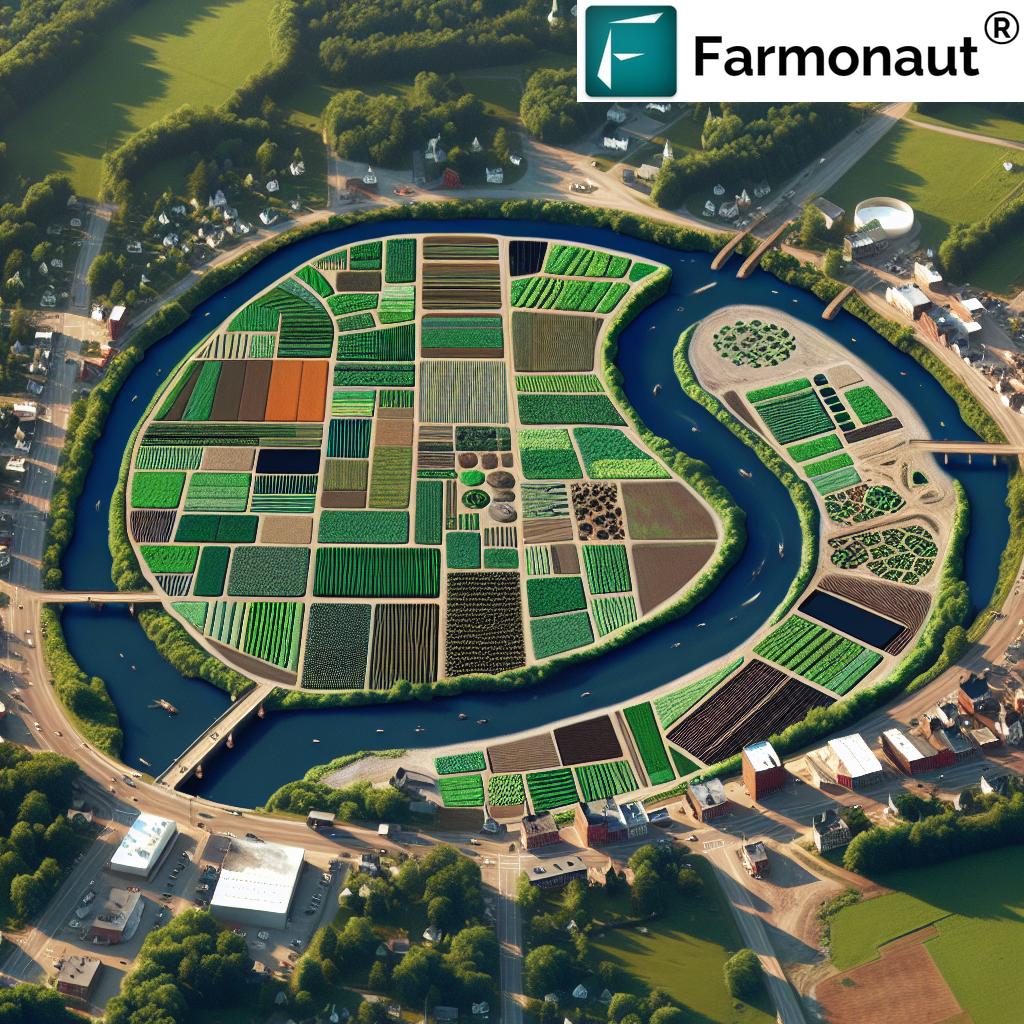Sustainable Agriculture Meets River Conservation: Pepperell’s Cultural Mural Tells Environmental Success Story
“The Nashua River watershed’s transformation from one of America’s most polluted to a pristine recreational resource took less than 50 years.”
In the heart of Massachusetts, a remarkable story of environmental restoration and sustainable agriculture unfolds along the banks of the Nashua River. We, as a community, have witnessed a transformation that speaks volumes about our collective commitment to preserving our natural heritage while embracing innovative farming practices. Today, we’ll explore how Pepperell’s cultural mural not only captures this journey but also serves as a testament to the power of community-driven change in agriculture and river conservation.
The Nashua River: A Journey from Pollution to Pristine Waters
The Nashua River, once one of the most polluted rivers in the United States, has undergone a remarkable transformation. This journey from an industrial dumping ground to a pristine recreational resource is a story of resilience, community action, and innovative agricultural practices. Let’s delve into the historical timeline that brought us to where we are today.
| Time Period | Agricultural Practices | Environmental Impact |
|---|---|---|
| Indigenous Times | Sustainable hunting and gathering, small-scale agriculture | Minimal impact, balanced ecosystem |
| Colonial Era (1600s-1700s) | Introduction of European farming methods, land clearing | Moderate impact, beginning of landscape changes |
| Industrial Revolution (1800s) | Shift to industrial agriculture, mill development | Increasing pollution, habitat destruction |
| Mid-20th Century | Intensive farming, heavy use of chemicals | Severe pollution, river ecosystem collapse |
| 1960s-1970s | Beginning of environmental awareness in farming | Start of cleanup efforts, slow improvement |
| 1980s-1990s | Introduction of sustainable farming practices | Noticeable river quality improvement |
| 2000s-Present | Precision agriculture, organic farming, community projects | Significant restoration, river becomes recreational |
This timeline illustrates the profound changes that have occurred in the Nashua River watershed. From the sustainable practices of indigenous peoples to the devastating effects of industrialization, and finally to the current era of environmental restoration and sustainable agriculture, we’ve come full circle in our relationship with the land and water.
The Cultural Mural: A Visual Narrative of Environmental Success
In Pepperell, a remarkable cultural mural project is underway, capturing the essence of this environmental success story. The mural, titled “The History of the Nashua River in Pepperell,” is more than just a beautiful piece of art; it’s a visual chronicle of our community’s journey towards sustainable agriculture and environmental restoration.

The mural, designed by artist Nan Quintin, consists of seven 4×8-foot panels that narrate the story of the Nashua River. From indigenous times to the colonial agricultural era and through various industrial phases, each panel represents a significant period in our region’s agricultural and environmental history. The final panels celebrate the river’s current pristine condition, made possible by ongoing environmental oversight and sustainable farming practices.
From Indigenous Wisdom to Colonial Agriculture
The first panels of the mural take us back to a time when indigenous peoples lived in harmony with the land. Their sustainable practices, deeply rooted in respect for nature, set the stage for the agricultural history of our region. As we moved into the colonial era, European settlers brought new farming techniques to the Nashua River valley. While these methods increased productivity, they also began to alter the natural landscape.
The Industrial Revolution: A Double-Edged Sword
The industrial revolution brought rapid changes to Pepperell and the surrounding areas. Mills sprang up along the Nashua River, powering economic growth but at a significant environmental cost. The river, once teeming with life, became a dumping ground for industrial waste. This period marked the beginning of severe pollution in our waterways, a challenge that would take decades to overcome.
The Turning Point: Environmental Awakening
The mid-20th century saw a growing awareness of the environmental impact of industrial and agricultural practices. This awakening is beautifully captured in the mural, highlighting the efforts of environmental pioneers like Marion Stoddart. Her work in the 1960s was instrumental in transforming the Nashua River from one of the most polluted rivers in America to the clean waterway we enjoy today.
“Sustainable agriculture practices in Pepperell have reduced agricultural runoff by up to 30% in the last decade.”
Modern Era: Embracing Sustainable Agriculture
Today, the Nashua River watershed is a testament to the power of sustainable agriculture and community-based environmental projects. Farmers in our region have embraced precision farming technologies and sustainable practices that not only increase productivity but also protect our precious water resources.
For instance, many local farms now use advanced crop monitoring and management techniques to optimize resource use and minimize environmental impact. These technologies, similar to those offered by companies like Farmonaut, allow farmers to make data-driven decisions about irrigation, fertilizer application, and pest management.
Community-Based Agricultural Projects: The Heart of Change
One of the most inspiring aspects of our region’s transformation is the role of community-based agricultural projects. These initiatives have been crucial in promoting sustainable farming practices and educating the public about the importance of environmental conservation.
- Community Gardens: Pepperell now boasts several community gardens where residents can grow their own produce using organic methods.
- Farm-to-Table Programs: Local restaurants and schools have partnered with farmers to source fresh, sustainably grown produce.
- Educational Workshops: Regular workshops teach sustainable farming techniques to both hobbyist gardeners and professional farmers.
These projects not only contribute to sustainable agriculture but also foster a sense of community and shared responsibility for our environment.
Precision Agriculture: A Game-Changer for Environmental Conservation
The adoption of precision agriculture technologies has been a game-changer in our efforts to balance productive farming with environmental conservation. These technologies allow farmers to optimize their use of resources, reducing waste and minimizing environmental impact.
For example, satellite-based farm management solutions, like those provided by Farmonaut, offer real-time crop health monitoring and AI-based advisory systems. These tools enable farmers to:
- Monitor crop health remotely, reducing the need for physical inspections
- Optimize irrigation based on precise soil moisture data
- Apply fertilizers and pesticides only where and when needed
- Predict and mitigate potential crop diseases or pest infestations
By leveraging these technologies, our local farmers have significantly reduced their environmental footprint while maintaining or even increasing crop yields.

Soil and Water Conservation: The Foundation of Sustainable Farming
At the heart of our agricultural transformation are advanced soil and water conservation techniques. These practices not only protect our natural resources but also ensure long-term agricultural sustainability.
Key Conservation Techniques:
- Cover Cropping: Planting cover crops between growing seasons to prevent soil erosion and improve soil health.
- No-Till Farming: Minimizing soil disturbance to maintain soil structure and reduce erosion.
- Precision Irrigation: Using advanced systems to deliver water exactly where and when crops need it, reducing waste and runoff.
- Buffer Strips: Creating vegetated areas along waterways to filter runoff and protect water quality.
These techniques have been instrumental in reducing agricultural runoff and protecting the Nashua River from pollution.
The Role of Technology in Modern Farming
As we continue to evolve our agricultural practices, technology plays an increasingly vital role. Farmers in our region are now leveraging a variety of tools to make informed decisions and minimize their environmental impact.
Some key technologies being adopted include:
- Satellite Imagery: For monitoring crop health and identifying issues early.
- IoT Sensors: To collect real-time data on soil moisture, temperature, and other critical factors.
- AI and Machine Learning: For predictive analytics in crop management and disease prevention.
- Drones: For precise application of inputs and detailed crop surveys.
These technologies, available through platforms like Farmonaut, are helping our farmers make data-driven decisions that benefit both their yields and the environment.
The Impact on Local Economy and Community
The shift towards sustainable agriculture has had a profound impact on our local economy and community. We’ve seen:
- Increased demand for locally grown, sustainably produced food
- Growth in agri-tourism, with farms offering tours and educational experiences
- New job opportunities in sustainable farming and related technologies
- Improved quality of life due to cleaner water and air
These changes have not only boosted our local economy but have also strengthened our community bonds and sense of shared environmental responsibility.
Looking to the Future: Challenges and Opportunities
While we’ve made significant progress, there are still challenges ahead. Climate change, water scarcity, and the need to feed a growing population are issues that require ongoing innovation and commitment to sustainable practices.
However, with continued adoption of precision agriculture technologies, community involvement, and a focus on sustainable practices, we are well-positioned to face these challenges. The story of the Nashua River’s transformation from a polluted waterway to a pristine resource serves as an inspiration and a blueprint for future conservation efforts.
The Mural: A Symbol of Our Commitment
As the cultural mural nears completion, it stands as a powerful symbol of our community’s journey and ongoing commitment to sustainable agriculture and environmental conservation. Each brushstroke tells a story of transformation, resilience, and hope.
The open house scheduled for Sunday, January 12, at the Fitzpatrick Collaborative, offers an opportunity for community members to witness this artistic representation of our shared history and future aspirations. It’s a chance to reflect on how far we’ve come and to recommit to the principles of sustainable living that will guide us forward.
Conclusion: A Model for Sustainable Agriculture and River Conservation
The story of Pepperell and the Nashua River is more than just a local success; it’s a model for communities worldwide. It demonstrates how sustainable agriculture practices, innovative technologies, and community engagement can come together to create lasting positive change.
As we look at the mural that now graces our community, we’re reminded of the power of collective action and the importance of balancing agricultural productivity with environmental stewardship. The pristine waters of the Nashua River, once among the most polluted in the nation, now flow as a testament to what’s possible when a community comes together with a shared vision of sustainability.
We invite you to visit Pepperell, to walk along the Nashua River Rail Trail, and to see firsthand how sustainable agriculture and river conservation can coexist and thrive. Let our story inspire you to take action in your own community, to embrace sustainable practices, and to believe in the power of transformation.
FAQs
- Q: How long did it take to clean up the Nashua River?
A: The major cleanup efforts began in the 1960s and significant improvements were seen within a few decades. However, the process of fully restoring the river to its current pristine state took about 50 years of consistent effort and policy changes. - Q: What role did Marion Stoddart play in the river’s restoration?
A: Marion Stoddart was a key environmental activist who spearheaded efforts to clean up the Nashua River in the 1960s. Her advocacy led to significant policy changes and community involvement in river conservation efforts. - Q: How has sustainable agriculture contributed to the river’s health?
A: Sustainable agriculture practices have significantly reduced runoff and pollution entering the river. Techniques like precision farming, organic methods, and improved soil management have all played a role in maintaining water quality. - Q: What technologies are local farmers using for sustainable farming?
A: Local farmers are adopting various technologies including satellite-based crop monitoring, AI-driven advisory systems, precision irrigation, and IoT sensors for real-time data collection. Many are using platforms like Farmonaut for advanced farm management. - Q: How can visitors experience the cultural mural and learn about the river’s history?
A: Visitors can attend the open house on Sunday, January 12, at the Fitzpatrick Collaborative in Pepperell. Additionally, the mural will be publicly viewable on the Nashua River Rail Trail, offering a visual journey through the river’s history and restoration.
For those interested in exploring more about sustainable agriculture technologies, we recommend checking out Farmonaut’s web application, Android app, or iOS app. These tools provide valuable insights for modern, sustainable farming practices.
Additionally, for developers interested in integrating agricultural data into their own applications, Farmonaut offers an API with comprehensive developer documentation.



